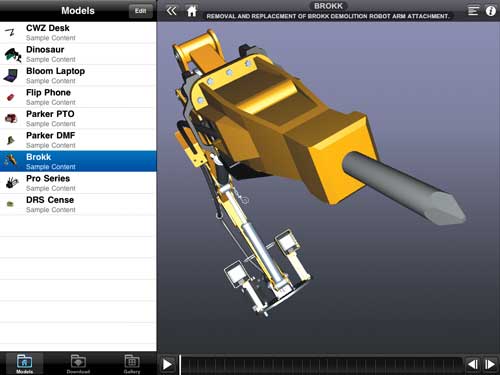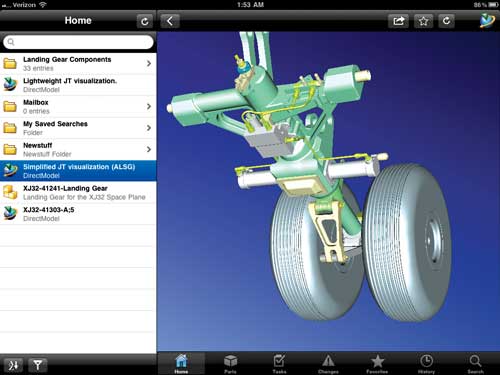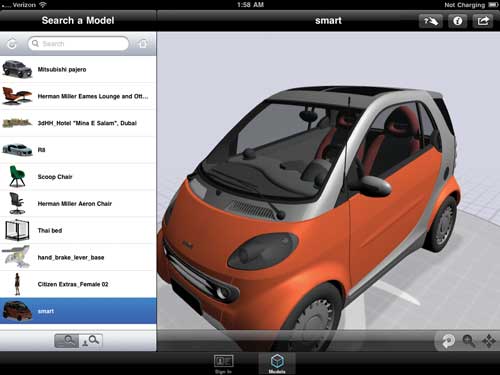Latest News
October 1, 2011
By Kenneth Wong
The invasion began with a few inconspicuous units, dropped behind enemy lines. At the PTC World Event in Orlando (June 6-9, 2010), a journalist took notes on Apple's latest tablet while Jim Heppelmann, PTC's CEO-elect at the time, talked about Project Lightning, a codename for the company's upcoming product launch. A few weeks later, at Siemens PLM Connection in Dallas (June 27-29, 2010), an analyst sheepishly tried to hide his iPad as he shook hands with a Microsoft executive. The gentleman from Windows reciprocated the analyst's professional courtesy by pretending not to notice the Apple device.
In October, when PTC finally revealed its new product family, Creo 1.0, it became clear the company was borrowing a page from Apple's playbook. In fact, Brian Shepherd, PTC's executive vice president of product development, borrowed Apple's marketing slogan—“There's an app for that!”—to explain PTC's strategy to break up an all-inclusive CAD-PLM package into a series of app-like modules. Around the same time, PTC's rival Dassault Systemes revealed 3DVIA Mobile for the iPad and iPhone, a mobile app for viewing 3D models.

Autodesk Inventor Publisher Mobile Viewer lets you view interactive 3D assembly instructions on mobile devices.
By the time Autodesk University came around in December 2010, some keynote speakers were openly flaunting the iPad—never mind that they were speaking to an audience made up primarily of Windows-based AutoCAD users. Longtime PC devotee Autodesk eventually paid homage to Apple and mobile devices by releasing a series of apps that target the iPhone, iPad and Android devices: AutoCAD WS Mobile, Autodesk Inventor Publisher Mobile Viewer and SketchBook Mobile, to name but a few.
Last spring, as Apple prepared to launch its second-generation tablet, the iPad 2, PLM (product lifecycle management) software makers were forced to rethink their R&D strategies. It became clear to them that traditional client-server approach—a central data repository, accessible via desktop terminals—was no longer sufficient. The old computing paradigm with firewall restrictions is bound to suffocate many in the new talent pool, who have been told they're free to roam. Aspiring engineers and designers have become too accustomed to their Wi-Fi-enabled freedom.
Design, engineering and manufacturing have long been decentralized. Global supply chains, offshore operations and transatlantic collaboration no longer raise eyebrows. From GM and Ford to Procter & Gamble, industry titans and small businesses alike have accepted them as standard practices. Yet, many PLM technologies remain trapped inside servers and desktops. Perhaps it's time to mobilize PLM, to get ready for the inevitable arrival of RLM: roaming lifecycle management.
The Great Shakeup
This June, at PTC's annual user conference (rebranded as PlanetPTC Live), PTC's Shepherd got one of the most enthusiastic rounds of applause when he shook an iPad—quite literally. Shepherd was demonstrating Windchill Mobility, an app that's not yet in the market. Developed to let users access product data housed in PTC's Windchill PLM system through a mobile device, the app also lets users shake the device to explode an assembly—an example of an innovative use of the device's sensitivity to movement.
Apple iPhone and iPad offer a way to undo an action (most notably, to undo a string of text you just typed) by shaking the unit. In essence, it encourages you to do something you've been traditionally told not to do with your computing devices!
Similarly, mobile devices' touch-responsiveness encourages you to interact with digital design data—2D drawings and 3D models—differently. This distinct characteristic makes it possible to bypass the mouse altogether when launching, zooming, panning, selecting, rotating and editing CAD models in the latest crop of mobile apps developed by CAD and PLM vendors—including Autodesk Inventor Publisher Mobile Viewer, AutoCAD WS, Dassault Systemes' 3DVIA Mobile, IMSI/Design's TurboViewer and Siemens PLM Software's Teamcenter Mobility.
“Laptops and notebooks have been able to connect wirelessly through add-on air cards for some time,” observes Siemens PLM Software in a white paper, “A Mobility Strategy for PLM Users.” “Recently, interest has increased in a new breed of tablets popularized by the Apple iPad and the Android platform. Seemingly overnight, product development companies are procuring tablets for their own mobile workforce, and requiring their enterprise software solutions to support these mobile devices. According to Forrester Research, the enterprise mobile workforce represented 57% of employees in 2010 and is expected to grow to as much as 93% by 2015.”

Siemens PLM Software's Teamcenter Mobility lets you use an iPad to search and retrieve design data and bills of materials housed in a Teamcenter repository. 3D visualization is made possible by Siemens PLM Software's lightweight JT format.
Downstream use of CAD data, often touted by PLM advocates as one of the benefits, was previously fueled by lightweight client apps, installed on desktops or laptops (for example, SolidWorks' eDrawings Viewer or Cimmetry AutoVue, later acquired by Oracle). But the popularity of mobile devices among road warriors and field technicians suggest the function will soon shift to smartphones and tablets.
To address this sea change, some design software makers like Autodesk and Dassault Systemes now offer the ability to publish mobile device-displayable animations, dynamic documents and interactive manuals through products like Autodesk Inventor Publisher and 3DVIA Composer.
Naturally, discussions of mobile computing may set off some alarm bells, as the new devices are not always easy to control or track. For IP-conscious manufacturers, they could be a huge IT headache. But surprisingly, PC maker Dell comes to the defense of the new kids: “Corporate IT policies that ban the use of employee-owned devices in the name of security inadvertently create new bigger security holes as users skirt IT restrictions,” Dell noted in its paper “CIO Strategies for Consumerization: The Future of Enterprise Mobile Computing” (Feb. 3, 2011).
An Unsettled Market
Chuck Cimlore, CEO of Omnify PLM Solutions, is looking at areas of his firm's software that are ripe for mobile deployment.
“The key features for general PLM users would center around viewing workflows, performing sign-offs, searching, data retrieval and document viewing,” he notes. “Field and shop floor personnel would require additional functionality for scanning and tracking manufactured and test units, raising corrective actions, and recoding returned materials.”
Five years ago, says Bill Barnes, general manager of Lattice Technology, “we were all about format. Our mantra was XVL, XVL, XVL—XVL everywhere, XVL on every desktop. ]XVL is Lattice's lightweight geometry display format.] Now, what I've noticed is the need to support multiple consumption devices: a tablet or handheld device, a touchscreen on the shop floor, a notebook with a PDF reader. As a vendor, we need to make sure we can support all those.”
Lattice's XVL Studio serves as a software suite for turning 3D design data into 3D manufacturing data and technical illustrations. Barnes acknowledges the increasing demand for mobile support, but the company's software currently doesn't include mobile publishing options.
Similarly, Omnify's Cimlore says, “The biggest challenge is supporting the wide array of operating systems. Like many, Omnify is taking the approach of developing a 'scaled-down' version of its browser-based products to provide streamlined functionality for mobile devices (through the device's browser). As demand increases for extended functionality for a specific mobile OS, we will develop apps accordingly.”
Supporting mobile devices via a browser may work as a shortcut, but the method can't take full advantage of a device's inherent features, like multi-touch navigation and gesture-based 3D navigation. In fact, early prototypes and PLM apps appear to treat the device primarily as a portable input terminal. Very few, for instance, take advantage of the device's location awareness and audiovisual features.

Dassault Systemes' 3DVIA Mobile Viewer lets you connect to the 3DVIA community online, download models and visualize them from an iPad.
Developing PLM apps for the iPad, iPhone and Android is the easy part (see “The Kindle Sync Model,” to the left). Figuring out a way to synchronize user operations across all platforms, operating systems, and devices so everyone involved in a project can view and access the same engineer change orders, geometry edits and supply chain shuffles—that's the difficult part. And that's what it'll take to maintain a single source of the truth when PLM goes mobile.
Exceptions to the Mobile Rule
In general, PLM tasks that can be performed remotely are also those that don't need a lot of CPU power. They include data search and retrieval, design review and approval, project status query, 3D data viewing and markup, and request for quotes and proposals. But certain design- and engineering-related tasks that require dedicated workstations and servers may not be suitable for mobile treatment yet. For a start, a mobile device's computing power is no substitute for a workstation's horsepower when it comes to running professional CAD, finite element analysis (FEA) and rendering software packages.
Peter Thorne, managing director for consulting and analyst firm Cambashi, proposes a hypothetical scenario: “Think of yourself as a passenger with a choice between two aircraft. You're told, 'The aircraft over there was designed by engineers working at their desks, using 31-in. screens and high-performance workstations. The one over here was designed by engineers using mobile devices.' Which one would you rather fly in?”
His point is, “There's a level at which the nature of the mobile device becomes a barrier itself,” due to its willing sacrifice of computing power and display screen.
With the help of partners like mental images (a division of NVIDIA), Autodesk has been working on allowing 3ds Max users to produce ray-traced rendering remotely. The new feature will allow 3ds Max users to remotely tap into the processing powers of Tesla GPUs housed elsewhere to render their designs and animations faster. By the same token, engineering and simulation software provider Altair has begun offering users the option to remotely call up the company's computing resources to perform simulation jobs.
Current barriers—primarily difficulties in moving large data to and from mobile devices—may disappear in the future as software and hardware makers invent new ways to bypass the need for local processing power. For instance, you may borrow a remote workstation or buy time on a remote server to perform your computing-intense tasks. This raises the possibility that you may, indeed, be able to use a mobile device as an intermediary to connect to a high-performance computing system hosted elsewhere, making your device's processing power (or the lack of it) irrelevant.
“If you're going to use a mobile device to do that ]serious design engineering work],” cautions Thorne, “you'd better have a jolly good app to help you achieve the precision that comes more naturally on a traditional desktop workstation. It's horses for courses. Mobile is great for viewing, collaborating, and markup but not my first choice for authoring.”
Roaming Product Data
In August, as if conceding to the invading mobile horde, HP announced it was considering an exit strategy from the PC business.
“The personal computing market is quickly evolving with new form factors and application ecosystems,” HP observed in the announcement. Though not explicit, the reference is understood as mobile devices and tablets. At any rate, HP is considering a number of options for its Personal System Group, including “the separation of its PC business into a separate company through a spin-off or other transaction.” (For more, read “HP Ponders Exit Strategy from PC Business,” DE Virtual Desktop blog, Aug. 19, 2011.)
A week later, United Airlines announced it was giving its United and Continental Airlines pilots 11,000 iPads, preloaded with flight manuals. Alaska Airlines has also taken the same approach, paving the way for paperless cockpits. These moves are a clear sign that aerospace—the bread and butter of PLM—has embraced the idea to deliver mission-critical engineering data and technical documents on mobile devices. PLM data is now literally in the cloud. If your PLM software is still locked behind an air-conditioned server room, hidden behind a corporate firewall, you may be the one missing the flight.
Kenneth Wong writes about technology, its innovative use, and its implications. One of DE's MCAD/PLM experts, he has written for numerous technology magazines and writes DE's Virtual Desktop blog at deskeng.com/virtual_desktop. You can follow him on Twitter at KennethwongSF, or email him via [email protected].
For More Info
Altair Engineering Inc.
Apple
Autodesk
Cambashi
Dassault Systemes
Dell
IMSI/Design
Lattice Technology
mental images
NVIDIA Corp.
Omnify Software
Oracle
PTC
Siemens
Subscribe to our FREE magazine, FREE email newsletters or both!
Latest News
About the Author
Kenneth Wong is Digital Engineering’s resident blogger and senior editor. Email him at [email protected] or share your thoughts on this article at digitaleng.news/facebook.
Follow DE





